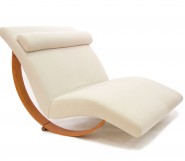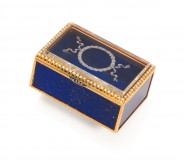Lot #34 - Jeffrey Smart
-
Auction House:Deutscher and Hackett
-
Sale Name:Important Australian + International Fine Art
-
Sale Date:04 May 2016 ~ 7pm
-
Lot #:34
-
Lot Description:Jeffrey Smart
(1921 – 2013)
First Oil Study For Ring – A – Rosy, 1986
oil on canvas
32.5 x 52.0 cm
signed lower right: JEFFREY SMART -
Provenance:Australian Galleries, Melbourne (label attached verso); Private collection, Tasmania
-
Notes:Creating a visual tension between the urban landscape and the natural environment, Jeffrey Smart illustrates the strength of modernity through the depiction of highways, road signs and imposing concrete buildings. The elevation of prosaic objects and structures into significant forms that attract and delight the eye is Smart's forte, as demonstrated in First Oil Study for Ring – a – Rosy, 1986. Against a brooding sky, a copse of pine trees line steep cliff faces that capture and reflect the sunlight. An apartment building – a beacon of urbanisation and a symbol of banal beauty – sits soberly in the background, demonstrating no sign of life within. The only suggestion of life is the small group of figures engaged in a lively game of Ring-a-Ring o’ Roses under the pine trees. The human figure is an important device throughout Smart's oeuvre, providing scale and perspective against the background. Many of his figures are kept at a distance and estranged from the viewer, sometimes their backs are turned towards us or perhaps their eyes are closed, creating a divide that we cannot breach as demonstrated in First Oil Study for Ring – a – Rosy, 1986. In the picture on offer, the features of the figures are imperceptible, reduced to small dabs of colour. Their disconnection to the viewer intensifies the isolating overtones, epitomised by the characteristic Smart figures, as they are ‘invariably, emotionally remote, distanced and wholly unengaged with either their surrounds or us, the viewer.’1 And yet, despite their insignificant size against the natural and urban landscape, the bright figures are full of movement and joie de vivre as they are captured mid-dance. The affable connection between the dancers is a rare feature in Smart’s oeuvre, as often his figures are detached from each other or forced into a disturbing relationship, between a voyeur and an exhibitionist.2 In First Oil Study for Ring – a – Rosy, 1986, a rare dynamic is presented as the figures are embracing in a ‘truly mutual way’,3 reflecting the bliss and wonder of childhood games. This subject has also been favoured by other Australian artists, including Tom Roberts. His etching of Ring O’Roses, c.1895 was followed by a similar subject in his sweeping panorama Australian Pastoral, 1904-05 in the collection of the National Gallery of Australia, Canberra. His subject, viewed from Cremorne Point, features a prominent circular group of figures dancing gracefully beside a grove of trees. There is something idyllic about First Oil Study for Ring – a – Rosy, 1986 through the carefree exuberance of the dancers. However, the tones of the ominous sky and the dark ocean, combined with the thoughtfully structured composition and the theatrical interplay of light and dark, create an eerie stillness as the picture is expectant with premonition. Such mechanisms have cemented Smart's position as one of Australia's most significant modern artists; as Edmund Capon suggests, there is only one Jeffrey Smart, 'He emulates nobody, and nobody emulates him – at least with any degree of authenticity.'4 1. Capon, E., Jeffrey Smart Retrospective, Art Gallery of New South Wales, Sydney, 1999, p. 17 2. Allen, C., Jeffrey Smart: Unpublished Paintings 1940 – 2007, Australian Galleries, Melbourne, 2008, p. 40 3. Ibid., p. 42 4. Capon, E., op. cit., p. 12 CASSI YOUNG 150690 ALAN SUMNER (1911 – 1994) HILL TRAIN TERMINUS FERNTREE GULLY, 1948 oil on canvas In a newspaper interview in 1990, Alan Sumner reflected on his extensive career, commenting ‘(m)y work is about anticipation, the next step, the stillness between what is to happen next … about people just waiting.’1 This deliberate mood of suspended animation haunts Hill Train Terminus, Ferntree Gully, 1948. Glimpsed as if from a passing carriage, the viewer’s eye immediately fixes on the lone figure caught in the act of switching tracks, a task we assume was completed but will never witness. All around is a contrasting sense of agitation, through the sweeping lines of the tracks themselves, the windswept trees and the rearing bulky forms of the train and shed. It is a remarkable composition that bears all the hallmarks of both Sumner’s extended studies with the modernist George Bell, and his allied career as a prolific stained glass designer. By 1948, when Hill Train Terminus, Ferntree Gully was painted, Alan Sumner had been teaching at the National Gallery School for two years after being de-mobbed from the Royal Australian Air Force. Prior to this, he had studied extensively with George Bell and worked at E.L. Yencken & Co.’s stained glass company under the tutelage of the artist William ‘Jock’ Frater. 1948 too was the year that his painting Lysterfield Landscape, c.1946 was awarded the George Crouch Memorial Prize at the Ballarat Art Gallery; and was also the time when Sumner emerged as an Australian pioneer of fine art silkscreens. As such, this painting dates from one of the most fertile periods of the artist’s career. Shortly after its first exhibition, the Sydney artist Herbert Badham reproduced Hill Train Terminus, Ferntree Gully in his influential publication A Study of Australian Art. 2 Sumner’s paintings are not only imaginative and satisfyingly designed; they are also scrupulously crafted having started as plein air sketches before being reworked in his Collingwood studio. Apart from the technical skills gleaned from George Bell, Sumner made numerous experiments with media whist perfecting his own silkscreen process, stating ‘I had to be my own chemist and invent my own paint from a little of this and a little of that, the earth colours for preference. Each colour was put out in a jar on the roof in the sun to test its permanency. Many were rejected as fugitive. Many oils were also tested in the sun in this way and beautifully pure stand oils resulted.’3 This same level of precise experimentation naturally informed his paintings which are constructed with meticulous attention to their material qualities. Sumner subsequently printed a silkscreen version of Hill Train Terminus which he considered the most ambitious from the series of fifty – and its culmination. 1. Trioli, V., ‘1940s art retains impact’, The Age, Melbourne, 17 September 1990, p. 14 2. Badham, H., A Study of Australian Art, Currawong, Sydney, 1949 3. Sumner, A., quoted in Butler, R., Alan Sumner – Screenprints, Eastgate Gallery, Melbourne, 1993, p. 16 ANDREW GAYNOR
-
Estimate:A$50,000 - 70,000
-
Realised Price:
-
Category:Art
This Sale has been held and this item is no longer available. Details are provided for information purposes only.










